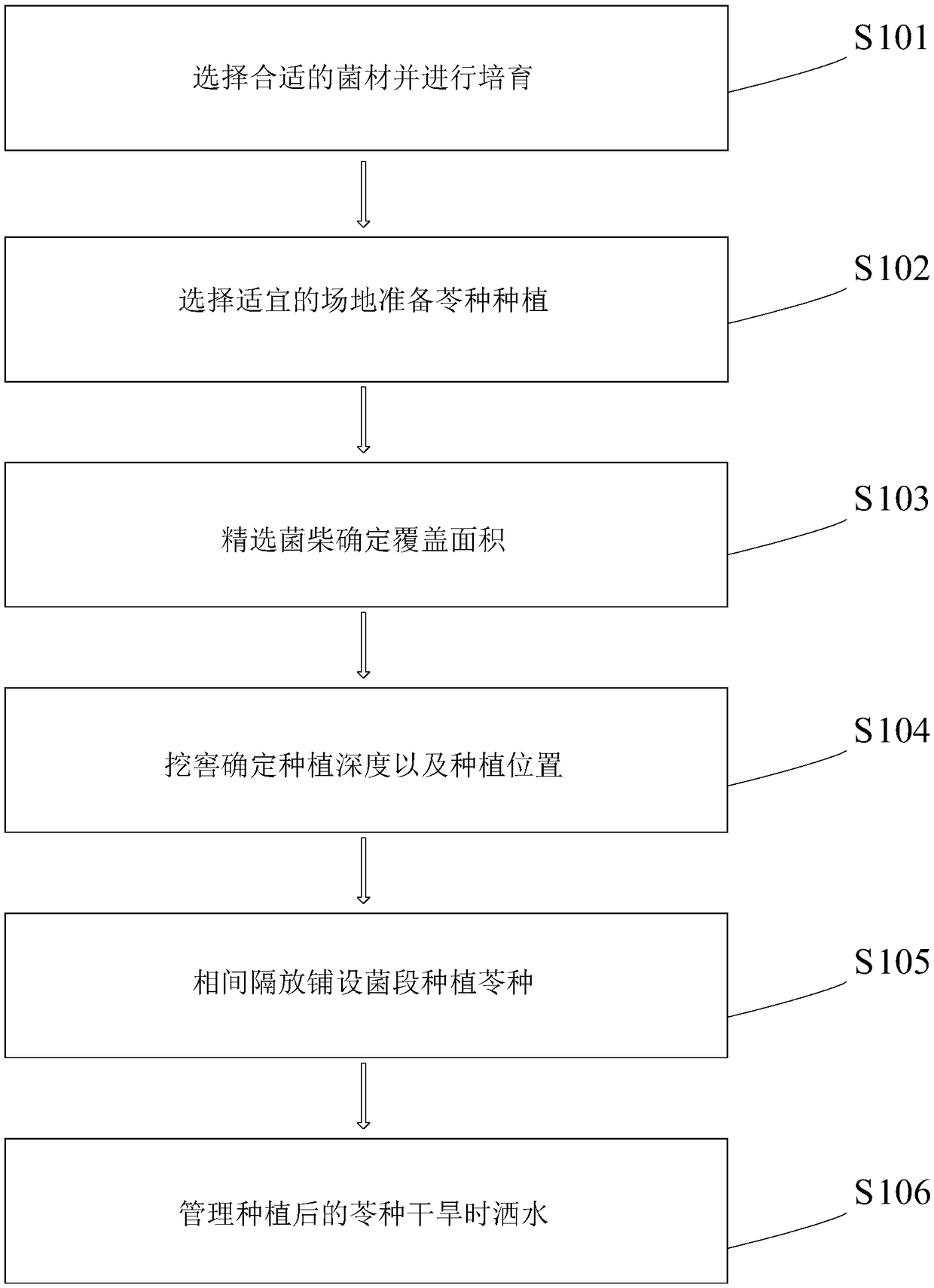Polyporus umbellatus bionic planting method
A technology of ecological planting and polyporus imitation, applied in botany equipment and methods, plant cultivation, horticulture, etc., can solve the problems of complex planting methods, inconvenient management, low yield, etc., achieve simple planting methods and ensure planting survival rate , the effect of ensuring the survival rate
- Summary
- Abstract
- Description
- Claims
- Application Information
AI Technical Summary
Problems solved by technology
Method used
Image
Examples
specific Embodiment 1
[0052] Common cultivation methods:
[0053] (1) Select appropriate fungus material and cultivate:
[0054] Choose a suitable tree species as the fungus material, collect branches or wood segments before the tree species grow new leaves, and cut the collected branches or wood segments into fish scales within a reasonable range; then prepare the dense ring strain, and then the prepared branches or The wood sections and the collected fungi are placed neatly in a 3:1 ratio from March to April, and then the dense ring fungi cut into pieces are sprinkled on top, and the gaps are filled with humus soil to cover them completely. Branches or wood sections are covered with a layer of leaves; pile up according to this requirement, and cover the surrounding soil, and then cover with air-permeable branches; when the weather is dry, water should be sprayed to maintain humidity; cultivate the fungus material and reserve it;
[0055] (2) Choose an appropriate site to prepare Ling seed planting:
[0...
specific Embodiment 2
[0066] Forest cultivation method:
[0067] Cultivation woodland selection, you can choose altitude, slope or forest type), then prepare the fungus material, you can choose tree sticks or branches), then prepare the polyporus umbellatus species and prepare the armillaria, then cultivate, cover, and manage And harvesting, the specific method is planting from bottom to top, under the forest in terraced cultivation, removing small trees, leaving big trees, without destroying the forest, digging a hole from 20 cm to 25 cm in depth and 70 cm to 75 cm in width; Depending on the topography of the forest, the first row is planted, the second row is excavated to cover the first row, just to cover the humus excavated in the second row to the first row, and the third row to cover the second row. By analogy, it saves labor and time; the use of under-forest shading eliminates the need to build shade sheds; the under-forest has tree roots to moisturize and regulate water, and cultivated Polypor...
specific Embodiment 3
[0069] Open field cultivation method:
[0070] Cultivation site selection, fungus preparation, tree sticks or branches can be selected), and then humus soil preparation and polyporus species preparation, armillaria preparation, followed by cultivation, covering, and setting up shade sheds, cutting grass 2 Management and harvesting can be carried out every time to 3 times. Use 5 to 6 tree sticks (diameter 8cm to 15cm, length 50cm to 55cm) for each hole, and 5 kg to 8 kg of branches (diameter 1cm to 3 cm, length 5cm to 8cm), 2 to 3 bottles of strain, 1 kg to 1.5 kg of Polyporus umbellatus, the specific method is:
[0071] (1) Dig the pit from 10 cm to 20 cm deep and 60 cm to 65 cm wide. The length depends on the terrain. Long trenches can also be excavated for cultivation. The bottom of the pit is loosened and leveled. The hole is filled with humus. 3 cm to 5 cm;
[0072] (2) Put 5 to 6 tree sticks, leaving 5 cm to 8 cm gaps between the tree sticks and the tree sticks;
[0073] (3) Ba...
PUM
 Login to View More
Login to View More Abstract
Description
Claims
Application Information
 Login to View More
Login to View More - R&D
- Intellectual Property
- Life Sciences
- Materials
- Tech Scout
- Unparalleled Data Quality
- Higher Quality Content
- 60% Fewer Hallucinations
Browse by: Latest US Patents, China's latest patents, Technical Efficacy Thesaurus, Application Domain, Technology Topic, Popular Technical Reports.
© 2025 PatSnap. All rights reserved.Legal|Privacy policy|Modern Slavery Act Transparency Statement|Sitemap|About US| Contact US: help@patsnap.com

